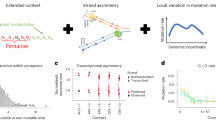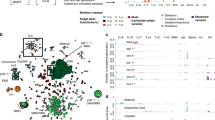Abstract
ORGANISMS vary greatly in genome size, that is, in the amount of DNA comprising the haploid genome. Rates of radiation-induced mutation expressed as mutations per locus per rad, also differ widely among organisms, but it is surprising that mutation rates and genome size are correlated1. This correlation is unexpected because proteins are of a similar size in all organisms, implying that structural genes must also be of a similar size. Accordingly, one would expect that, although the overall mutation rate would be proportional to the overall number of genes, the mutation rate per locus would be similar in all organisms or, at least, bear no relation to genome size. Surveying published data, however, Abrahamson et al.1 found a direct correlation between rate of radiation-induced mutation and size of the haploid genome from Escherichia coli to Hordeum vulgare (the ABCW relationship). We wondered whether rates of chemically induced mutation would also be related to genome size, both because of the practical importance of being able to extrapolate to the genetic effect of a chemical on the human population and because the information might help to elucidate the mechanism underlying the ABCW relationship.
This is a preview of subscription content, access via your institution
Access options
Subscribe to this journal
Receive 51 print issues and online access
$199.00 per year
only $3.90 per issue
Buy this article
- Purchase on Springer Link
- Instant access to full article PDF
Prices may be subject to local taxes which are calculated during checkout
Similar content being viewed by others
References
Abrahamson, S., Bender, M. A., Conger, A. D., and Wolff, S., Nature, 245, 460–462 (1973).
Judd, B. H., Shen, M. W., and Kaufman, T. C., Genetics, 71, 139–156 (1972).
Bishop, J. O., Cell, 2, 81–86 (1974).
Britten, R. J., and Davidson, E. H., Science, 165, 349–357 (1969).
King, M. C., and Wilson, A. C., Science, 188, 107–116 (1975).
Bridges, B. A., Environ. Hlth Perspect., 6, 221–227 (1973).
Crow, F., Environ. Hlth Perspect., 6, 1–5 (1973).
Lethbak, A., Christiansen, C., and Stenderup, A., J. gen. Microbiol., 64, 377–380 (1970).
Loveless, A., and Howarth, S., Nature, 184, 1780–1782 (1959).
Minagawa, T., Wagner, B., Strauss, B., Archs Biochem. Biophys., 80, 442–445 (1959).
de Serres, F. J., Brockman, H. E., Barnett, W. E., and Kølmark, H. C., Mutat. Res., 12, 129–142 (1971).
Ogur, M., Minckler, S., Lindegren, G., and Lindegren, C. C., Archs Biochem. Biophys., 40, 175–184 (1952).
Loprieno, N., Mutat. Res., 3, 486–493 (1966).
Lim, J. K., and Snyder, L. A., Mutat. Res., 6, 129–137 (1968).
Alikhanian, S. J., Zool. Zhur., 16 (1937).
Bennett, M. D., Proc. R. Soc., B 181, 109–135 (1972).
Rédei, G. P., and Li, S. L., Genetics, 61, 453–459 (1969).
Moh, C. C., Mutat. Res., 7, 469–471 (1969).
Bachmann, K., Chromosoma, 37, 85–93 (1972).
Chu, E. H. Y., and Mailing, H. V., Genetics, 61, 1306–1312 (1968).
Amano, E., and Smith, H. H., Mutat. Res., 2, 344–351 (1965).
Rees, H., and Jones, R. N., Int. Rev. Cytol., 32, 53 (1972).
Ardashnikov, S. N., Soyfer, V. N., and Goldfarb, D. M., Biochem. biophys. Res. Commun., 16, 455–459 (1964).
Strauss, B. S., Nature, 191, 730–731 (1961).
Brown, D. F., Mutat. Res., 3, 365–373 (1966).
Sinsheimer, R. L., Procedures in Nucleic Acid Research (edit. by Cantoni, and Davies), 559–576 (Harper and Row, New York, 1966).
Tessman, I., Poddar, R. K., and Kumar, S., J. molec. Biol., 9, 352–363 (1964).
Author information
Authors and Affiliations
Additional information
The erratum article can be found online at https://doi.org/10.1038/259248a0
Rights and permissions
About this article
Cite this article
HEDDLE, J., ATHANASIOU, K. Mutation rate, genome size and their relation to the rec concept. Nature 258, 359–361 (1975). https://doi.org/10.1038/258359a0
Received:
Accepted:
Issue Date:
DOI: https://doi.org/10.1038/258359a0
This article is cited by
-
The polarity protein PARD3 and cancer
Oncogene (2021)
-
A plot of G + C content against sequence length of 640 bacterial chromosomes shows the points are widely scattered in the upper triangular area
Chromosome Research (2009)
-
Is recombination confined to structural genes on the eukaryotic genome?
Nature (1977)
-
Differential mutagenic response in selected lines of Drosophila melanogaster
Theoretical and Applied Genetics (1977)
Comments
By submitting a comment you agree to abide by our Terms and Community Guidelines. If you find something abusive or that does not comply with our terms or guidelines please flag it as inappropriate.



